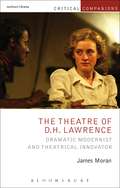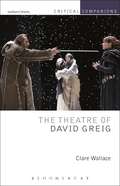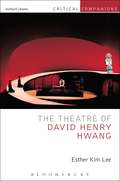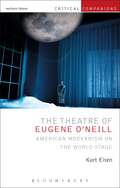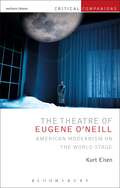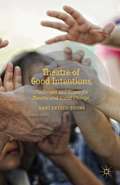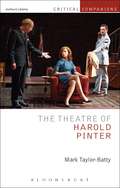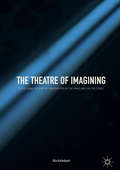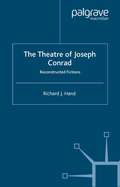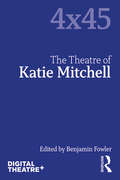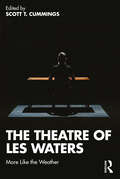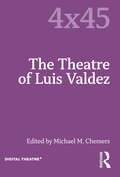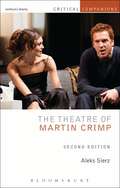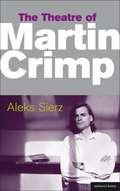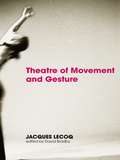- Table View
- List View
The Theatre of D.H. Lawrence: Dramatic Modernist and Theatrical Innovator (Critical Companions)
by James MoranThis is the first major book-length study for four decades to examine the plays written by D. H. Lawrence, and the first ever book to give an in-depth analysis of Lawrence's interaction with the theatre industry during the early twentieth century. It connects and examines his performance texts, and explores his reaction to a wide-range of theatre (from the sensation dramas of working-class Eastwood to the ritual performances of the Pueblo people) in order to explain Lawrence's contribution to modern drama. F. R. Leavis influentially labelled the writer 'D. H. Lawrence: Novelist'. But this book foregrounds Lawrence's career as a playwright, exploring unfamiliar contexts and manuscripts, and drawing particular attention to his three most successful works: The Widowing of Mrs Holroyd, The Daughter-in-Law, and A Collier's Friday Night. It examines how Lawrence's novels are suffused with theatrical thinking, revealing how Lawrence's fictions – from his first published work to the last story that he wrote before his death – continually take inspiration from the playhouse. The book also argues that, although Lawrence has sometimes been dismissed as a restrictively naturalistic stage writer, his overall oeuvre shows a consistent concern with theatrical experiment, and manifests affinities with the dramatic thinking of modernist figures including Brecht, Artaud, and Joyce. In a final section, the book includes contributions from influential theatre-makers who have taken their own cue from Lawrence's work, and who have created original work that consciously follows Lawrence in making working-class life central to the public forum of the theatre stage.
The Theatre of D.H. Lawrence: Dramatic Modernist and Theatrical Innovator (Critical Companions)
by James MoranThis is the first major book-length study for four decades to examine the plays written by D. H. Lawrence, and the first ever book to give an in-depth analysis of Lawrence's interaction with the theatre industry during the early twentieth century. It connects and examines his performance texts, and explores his reaction to a wide-range of theatre (from the sensation dramas of working-class Eastwood to the ritual performances of the Pueblo people) in order to explain Lawrence's contribution to modern drama. F. R. Leavis influentially labelled the writer 'D. H. Lawrence: Novelist'. But this book foregrounds Lawrence's career as a playwright, exploring unfamiliar contexts and manuscripts, and drawing particular attention to his three most successful works: The Widowing of Mrs Holroyd, The Daughter-in-Law, and A Collier's Friday Night. It examines how Lawrence's novels are suffused with theatrical thinking, revealing how Lawrence's fictions – from his first published work to the last story that he wrote before his death – continually take inspiration from the playhouse. The book also argues that, although Lawrence has sometimes been dismissed as a restrictively naturalistic stage writer, his overall oeuvre shows a consistent concern with theatrical experiment, and manifests affinities with the dramatic thinking of modernist figures including Brecht, Artaud, and Joyce. In a final section, the book includes contributions from influential theatre-makers who have taken their own cue from Lawrence's work, and who have created original work that consciously follows Lawrence in making working-class life central to the public forum of the theatre stage.
The Theatre of David Greig (Critical Companions)
by Clare WallaceDavid Greig has been described as 'one of the most interesting and adventurous British dramatists of his generation' (Daily Telegraph) and 'one of the most intellectually stimulating dramatists around' (Guardian). Since he began writing for theatre in the early nineties, his work has been both copious and remarkably varied, defying neat generalisations or attempts to pigeon-hole his work. Besides his original plays, he has adapated classics, is co-founder of the Suspect Culture Theatre Group and is currently Dramaturge for the National Theatre of Scotland. This Critical Companion provides an analytical survey of his work, from his early plays such as Europe and The Architect through to more recent works Damascus, Dunsinane and Ramallah; it also considers the plays produced with Suspect Culture and his work for young audiences. As such it is the first book to provide a critical account of the full variety of his work and will appeal to students and fans of contemporary British theatre.Clare Wallace provides a detailed analysis of a broad selection of plays and their productions, reviews current discourses about his work and offers a framework for enquiry. The Companion features an interview with David Greig and a further three essays by leading academics offering a variety of critical perspectives.
The Theatre of David Greig (Critical Companions)
by Clare WallaceDavid Greig has been described as 'one of the most interesting and adventurous British dramatists of his generation' (Daily Telegraph) and 'one of the most intellectually stimulating dramatists around' (Guardian). Since he began writing for theatre in the early nineties, his work has been both copious and remarkably varied, defying neat generalisations or attempts to pigeon-hole his work. Besides his original plays, he has adapated classics, is co-founder of the Suspect Culture Theatre Group and is currently Dramaturge for the National Theatre of Scotland. This Critical Companion provides an analytical survey of his work, from his early plays such as Europe and The Architect through to more recent works Damascus, Dunsinane and Ramallah; it also considers the plays produced with Suspect Culture and his work for young audiences. As such it is the first book to provide a critical account of the full variety of his work and will appeal to students and fans of contemporary British theatre.Clare Wallace provides a detailed analysis of a broad selection of plays and their productions, reviews current discourses about his work and offers a framework for enquiry. The Companion features an interview with David Greig and a further three essays by leading academics offering a variety of critical perspectives.
The Theatre of David Henry Hwang (Critical Companions)
by Esther Kim LeeSince the premiere of his play FOB in 1979, the Chinese American playwright David Henry Hwang has made a significant impact in the U. S. and beyond. The Theatre of David Henry Hwang provides an in-depth study of his plays and other works in theatre. Beginning with his "Trilogy of Chinese America", Esther Kim Lee traces all major phases of his playwriting career. Utilizing historical and dramaturgical analysis, she argues that Hwang has developed a unique style of meta-theatricality and irony in writing plays that are both politically charged and commercially viable.The book also features three essays written by scholars of Asian American theatre and a comprehensive list of primary and secondary sources on his oeuvre. This comprehensive study of Hwang's work follows his career both chronologically and thematically. The first chapter analyzes Hwang's early plays, "Trilogy of Chinese America," in which he explores issues of identity and cultural assimilation particular to Chinese Americans. Chapter two looks at four plays characterised as "Beyond Chinese America," which examines Hwang's less known plays. Chapter three focuses on M. Butterfly, which received the Tony Award for Best Play in 1988. In chapter four, Lee explores Hwang's development as a playwright during the decade of the 1990s with a focus on identity politics and multiculturalism. Chapter five examines Hwang's playwriting style in depth with a discussion of Hwang's more recent plays such as Yellow Face and Chinglish. The sixth chapter features three essays written by leading scholars in Asian American theatre: Josephine Lee on Flower Drum Song, Dan Bacalzo on Golden Child, and Daphne Lei on Chinglish. The final section provides a comprehensive compilation of sources: a chronology, a bibliography of Hwang's works, reviews and critical sources.
The Theatre of David Henry Hwang (Critical Companions)
by Esther Kim LeeSince the premiere of his play FOB in 1979, the Chinese American playwright David Henry Hwang has made a significant impact in the U. S. and beyond. The Theatre of David Henry Hwang provides an in-depth study of his plays and other works in theatre. Beginning with his "Trilogy of Chinese America", Esther Kim Lee traces all major phases of his playwriting career. Utilizing historical and dramaturgical analysis, she argues that Hwang has developed a unique style of meta-theatricality and irony in writing plays that are both politically charged and commercially viable.The book also features three essays written by scholars of Asian American theatre and a comprehensive list of primary and secondary sources on his oeuvre. This comprehensive study of Hwang's work follows his career both chronologically and thematically. The first chapter analyzes Hwang's early plays, "Trilogy of Chinese America," in which he explores issues of identity and cultural assimilation particular to Chinese Americans. Chapter two looks at four plays characterised as "Beyond Chinese America," which examines Hwang's less known plays. Chapter three focuses on M. Butterfly, which received the Tony Award for Best Play in 1988. In chapter four, Lee explores Hwang's development as a playwright during the decade of the 1990s with a focus on identity politics and multiculturalism. Chapter five examines Hwang's playwriting style in depth with a discussion of Hwang's more recent plays such as Yellow Face and Chinglish. The sixth chapter features three essays written by leading scholars in Asian American theatre: Josephine Lee on Flower Drum Song, Dan Bacalzo on Golden Child, and Daphne Lei on Chinglish. The final section provides a comprehensive compilation of sources: a chronology, a bibliography of Hwang's works, reviews and critical sources.
The Theatre of Eugene O’Neill: American Modernism on the World Stage (Critical Companions)
by Kurt EisenThe Theatre of Eugene O'Neill offers a new comprehensive overview of O'Neill's career and plays in the context of the American theatre. Organised thematically, it considers his Modernist intervention in the theatre, offers readers detailed analysis of the plays, and assesses the recent resurgence in his reputation and new approaches to staging his work. It includes a study of all his major plays - The Emperor Jones, The Hairy Ape, The Iceman Cometh, Long Day's Journey into Night, A Moon for the Misbegotten and Desire Under the Elms - besides numerous other full length and one act dramas.Eugene O'Neill is generally credited with inventing modern American drama, in a time of cultural ferment and lively artistic and intellectual change. Yet O'Neill's theatrical instincts were always shaped by American stage traditions that were inextricable from his sense of himself and his own national culture. This study shows that his theatrical modernism represents not so much a break from these traditions as a reinvention of their scope and significance in the context of international stage modernism, offering an image of national culture and character that opens new possibilities for the stage while remaining rooted in its past.Kurt Eisen traces O'Neill's Modernism throughout the dramatists's work: his attempts to break from the themes, plots, and moral conventions of the traditional melodramatic theatre; his experiments in stagecraft and theme, and their connection to traditional theatre and his European modernist contemporaries; the turn toward direct and indirect self-representation; and his critique of the family and of American 'pipe dreams' and the allure of success. The volume additionally features four contributed essays providing further critical perspectives on O'Neill's work, besides a chronology of the writer's life and times.
The Theatre of Eugene O’Neill: American Modernism on the World Stage (Critical Companions)
by Kurt EisenThe Theatre of Eugene O'Neill offers a new comprehensive overview of O'Neill's career and plays in the context of the American theatre. Organised thematically, it considers his Modernist intervention in the theatre, offers readers detailed analysis of the plays, and assesses the recent resurgence in his reputation and new approaches to staging his work. It includes a study of all his major plays - The Emperor Jones, The Hairy Ape, The Iceman Cometh, Long Day's Journey into Night, A Moon for the Misbegotten and Desire Under the Elms - besides numerous other full length and one act dramas.Eugene O'Neill is generally credited with inventing modern American drama, in a time of cultural ferment and lively artistic and intellectual change. Yet O'Neill's theatrical instincts were always shaped by American stage traditions that were inextricable from his sense of himself and his own national culture. This study shows that his theatrical modernism represents not so much a break from these traditions as a reinvention of their scope and significance in the context of international stage modernism, offering an image of national culture and character that opens new possibilities for the stage while remaining rooted in its past.Kurt Eisen traces O'Neill's Modernism throughout the dramatists's work: his attempts to break from the themes, plots, and moral conventions of the traditional melodramatic theatre; his experiments in stagecraft and theme, and their connection to traditional theatre and his European modernist contemporaries; the turn toward direct and indirect self-representation; and his critique of the family and of American 'pipe dreams' and the allure of success. The volume additionally features four contributed essays providing further critical perspectives on O'Neill's work, besides a chronology of the writer's life and times.
Theatre of Good Intentions: Challenges and Hopes for Theatre and Social Change
by D. Snyder-YoungTheatre of Good Intentions examines limitations of theatre in the creation of social and political change. This book looks at some of the reasons why achieving such goals is hard; examining what theatre can and can't do. It examines a range of applied and political theatre case studies, focusing on theatre's impact on participants and spectators.
The Theatre of Harold Pinter (Critical Companions)
by Mark Taylor-BattyThe plays of the late Nobel laureate Harold Pinter have formed part of the canon of world theatre since the 1960s. Frequently revived on the professional stage, and studied on almost every Theatre Studies course, his importance and influence is hard to overestimate. This Critical Companion offers an assessment of Pinter's entire body of work for the stage, appraising his skill as a dramatist and considering his impact and legacy. Through a clear focus on issues of theatricality and the effect of the plays in performance The Theatre of Harold Pinter considers Pinter's chief narrative concerns and offers a unifying theme through which over four decades of work may be understood. Plays are considered in themed chapters that follow the chronological sequence of work, illuminating the development of his aesthetic and concerns. The volume features too a series of essays from other leading scholars presenting different critical perspectives on the work, including Harry Burton on Pinter's early drama; Ann Hall on Revisiting Pinter's Women; Chris Megson on Pinter's Memory Plays of the 1970s, and Basil Chiasson on Neoliberalism and Democracy.
The Theatre of Harold Pinter (Critical Companions)
by Mark Taylor-BattyThe plays of the late Nobel laureate Harold Pinter have formed part of the canon of world theatre since the 1960s. Frequently revived on the professional stage, and studied on almost every Theatre Studies course, his importance and influence is hard to overestimate. This Critical Companion offers an assessment of Pinter's entire body of work for the stage, appraising his skill as a dramatist and considering his impact and legacy. Through a clear focus on issues of theatricality and the effect of the plays in performance The Theatre of Harold Pinter considers Pinter's chief narrative concerns and offers a unifying theme through which over four decades of work may be understood. Plays are considered in themed chapters that follow the chronological sequence of work, illuminating the development of his aesthetic and concerns. The volume features too a series of essays from other leading scholars presenting different critical perspectives on the work, including Harry Burton on Pinter's early drama; Ann Hall on Revisiting Pinter's Women; Chris Megson on Pinter's Memory Plays of the 1970s, and Basil Chiasson on Neoliberalism and Democracy.
The Theatre of Imagining: A Cultural History of Imagination in the Mind and on the Stage
by Ulla KallenbachThis book is the first comprehensive analysis of the fascinating and strikingly diverse history of imagination in the context of theatre and drama. Key questions that the book explores are: How do spectators engage with the drama in performance, and how does the historical context influence the dramaturgy of imagination? In addition to offering a study of the cultural history and theory of imagination in a European context including its philosophical, physiological, cultural and political implications, the book examines the cultural enactment of imagination in the drama text and offers practical strategies for analyzing the aesthetic practice of imagination in drama texts. It covers the early modern to the late modernist period and includes three in-depth case studies: William Shakespeare’s Macbeth (c.1606); Henrik Ibsen’s A Doll’s House (1879); and Eugène Ionesco’s The Killer (1957).
The Theatre of Imagining: A Cultural History of Imagination in the Mind and on the Stage
by Ulla KallenbachThis book is the first comprehensive analysis of the fascinating and strikingly diverse history of imagination in the context of theatre and drama. Key questions that the book explores are: How do spectators engage with the drama in performance, and how does the historical context influence the dramaturgy of imagination? In addition to offering a study of the cultural history and theory of imagination in a European context including its philosophical, physiological, cultural and political implications, the book examines the cultural enactment of imagination in the drama text and offers practical strategies for analyzing the aesthetic practice of imagination in drama texts. It covers the early modern to the late modernist period and includes three in-depth case studies: William Shakespeare’s Macbeth (c.1606); Henrik Ibsen’s A Doll’s House (1879); and Eugène Ionesco’s The Killer (1957).
The Theatre of Joseph Conrad: Reconstructed Fictions
by Richard J. HandAlthough the dramatic dimension to Joseph Conrad's fiction is frequently acknowledged, his own experiments in drama have traditionally been marginalized. However, in all of Conrad's plays we see a distinct effort to investigate seriously the dramatic form and some of his plays are startlingly ahead of their time. Furthermore, all of the plays are adaptations and comprise One Day More , based on Tomorrow , Laughing Anne , based on Because of the Dollars, Victory: A Drama and The Secret Agent . The creation of these reveals much about the history, theory and practice of this fascinating cultural process.
The Theatre of Katie Mitchell (4x45)
by Benjamin FowlerThis first volume in the 4x45 series investigates the work of theatre director Katie Mitchell. Pausing to reconsider a career in progress, it engages with some of Mitchell’s most recent work in the UK and Europe across theatre, opera, and Live Cinema. It also takes a longer view, considering the early turns that Mitchell took at the start of her career in the late 1980s. This volume gives full scope to the voice of the practitioner, alongside scholarly perspectives, in order to understand the work from within. Interviews with Mitchell’s collaborators get inside her process – and inside the thinking of key artists who help craft the distinctive visual, aesthetic and technological forms of Mitchell’s productions. Three major concerns criss-cross these contributions: the political implications of aesthetic form; the meaning of Mitchell’s interest in the radical project of early Naturalism; and the influence of Europe on Mitchell’s avant-garde experimentalism, which often draws on technology to open up new modes of perception and experience. An accessible and encompassing examination of one of Europe's most celebrated theatrical talents, 4x45 | The Theatre of Katie Mitchell is a unique resource for scholars,students and practitioners of Theatre Studies, Performance and Directing.
The Theatre of Katie Mitchell (4x45)
by Benjamin FowlerThis first volume in the 4x45 series investigates the work of theatre director Katie Mitchell. Pausing to reconsider a career in progress, it engages with some of Mitchell’s most recent work in the UK and Europe across theatre, opera, and Live Cinema. It also takes a longer view, considering the early turns that Mitchell took at the start of her career in the late 1980s. This volume gives full scope to the voice of the practitioner, alongside scholarly perspectives, in order to understand the work from within. Interviews with Mitchell’s collaborators get inside her process – and inside the thinking of key artists who help craft the distinctive visual, aesthetic and technological forms of Mitchell’s productions. Three major concerns criss-cross these contributions: the political implications of aesthetic form; the meaning of Mitchell’s interest in the radical project of early Naturalism; and the influence of Europe on Mitchell’s avant-garde experimentalism, which often draws on technology to open up new modes of perception and experience. An accessible and encompassing examination of one of Europe's most celebrated theatrical talents, 4x45 | The Theatre of Katie Mitchell is a unique resource for scholars,students and practitioners of Theatre Studies, Performance and Directing.
The Theatre of Les Waters: More Like the Weather
by Scott T. CummingsThe Theatre of Les Waters: More Like the Weather combines original writings from Les Waters with short essays by a wide range of his collaborators, creating a personal and multi-faceted portrait of an influential director, revered mentor, and inspirational theatre artist. The book begins with a critical introduction of Waters’s work, followed by essays written by a wide range of Waters's collaborators over the past four decades. These essays are framed by shorter pieces of writing by Waters himself: reflections, inspirations, observations, and personal anecdotes. At the heart of this book lies the notion that the director’s central position in theatrical production is defined by collaboration and that a study of directing should take into account how a director works with playwrights, designers, actors, stage managers, and dramaturgs to turn artistic vision into concrete reality on stage. An insightful resource for early career or student directors in theatre programs, The Theatre of Les Waters sheds light on the art of theatre directing by exploring the work of a major theatre artist whose accomplished career sits at the heart of American theatre in the 21st century. Drawing on aspects of memoir, case study, interview, miscellany, biography, and criticism, this is also an enlightening read for anyone with an interest in how theatre artists bring their creative vision to life.
The Theatre of Les Waters: More Like the Weather
by Scott T. CummingsThe Theatre of Les Waters: More Like the Weather combines original writings from Les Waters with short essays by a wide range of his collaborators, creating a personal and multi-faceted portrait of an influential director, revered mentor, and inspirational theatre artist. The book begins with a critical introduction of Waters’s work, followed by essays written by a wide range of Waters's collaborators over the past four decades. These essays are framed by shorter pieces of writing by Waters himself: reflections, inspirations, observations, and personal anecdotes. At the heart of this book lies the notion that the director’s central position in theatrical production is defined by collaboration and that a study of directing should take into account how a director works with playwrights, designers, actors, stage managers, and dramaturgs to turn artistic vision into concrete reality on stage. An insightful resource for early career or student directors in theatre programs, The Theatre of Les Waters sheds light on the art of theatre directing by exploring the work of a major theatre artist whose accomplished career sits at the heart of American theatre in the 21st century. Drawing on aspects of memoir, case study, interview, miscellany, biography, and criticism, this is also an enlightening read for anyone with an interest in how theatre artists bring their creative vision to life.
The Theatre of Luis Valdez (4x45)
by Michael M. ChemersThe Theatre of Luis Valdez focuses on the life and work of American playwright and director Luis Valdez, probably best known for his landmark 1979 play Zoot Suit – the first play by a Latinx playwright to appear on Broadway – and founder of El Teatro Campesino, the oldest surviving community theatre in the United States. Built around first-hand discussions of Valdez’s work, this collection gives an in-depth understanding of where ‘the godfather of Chicano theatre’ fits in the grand scheme of American drama and performance. Collaborators Edward James Olmos and Alma Martinez talk about working with Valdez and El Teatro Campesino; scholar Leticia Garcia interviews Jorge Huerta, the leading authority on Chicanx and Latinx theatre on the impact of Valdez work; and Luis Valdez himself contributes a lecture on all aspects of his craft from political resistance and the migrant experience to actor training and dramatic form. A concise and accessible study, 4x45 || Luis Valdez is the go-to resource for scholars, students and theatre practitioners looking for an introduction to this seminal figure in modern American performance.
The Theatre of Luis Valdez (4x45)
by Michael M. ChemersThe Theatre of Luis Valdez focuses on the life and work of American playwright and director Luis Valdez, probably best known for his landmark 1979 play Zoot Suit – the first play by a Latinx playwright to appear on Broadway – and founder of El Teatro Campesino, the oldest surviving community theatre in the United States. Built around first-hand discussions of Valdez’s work, this collection gives an in-depth understanding of where ‘the godfather of Chicano theatre’ fits in the grand scheme of American drama and performance. Collaborators Edward James Olmos and Alma Martinez talk about working with Valdez and El Teatro Campesino; scholar Leticia Garcia interviews Jorge Huerta, the leading authority on Chicanx and Latinx theatre on the impact of Valdez work; and Luis Valdez himself contributes a lecture on all aspects of his craft from political resistance and the migrant experience to actor training and dramatic form. A concise and accessible study, 4x45 || Luis Valdez is the go-to resource for scholars, students and theatre practitioners looking for an introduction to this seminal figure in modern American performance.
The Theatre of Martin Crimp: Second Edition (Critical Companions)
by Aleks SierzFirst published in 2006, Alek's Sierz's The Theatre of Martin Crimp provided a groundbreaking study of one of British theatre's leading contemporary playwrights. Combining Sierz's lucid prose and sharp analysis together with interviews with Martin Crimp and a host of directors and actors who have produced the work, it offered a richly rewarding and engaging assessment of this acutely satirical playwright. The second edition additionally explores the work produced between 2006 and 2013, both the major new plays and the translations and other work. The second edition considers The City, the 2008 companion play to The Country, Play House from 2012 and the new work for the Royal Court in late 2012. The two works that have brought Crimp considerable international acclaim in recent years, the updated rewrite of The Misanthrope which in 2009 played for several months in the West End starring Keira Knightley, and Crimp's translation of Botho Strauss's Big and Small (Barbican, 2012), together with Crimp's other work in translation are all covered. The Theatre of Martin Crimp remains the fullest, most readable account of Crimps's work for the stage.
The Theatre of Martin Crimp: Second Edition (Critical Companions)
by Aleks SierzFirst published in 2006, Alek's Sierz's The Theatre of Martin Crimp provided a groundbreaking study of one of British theatre's leading contemporary playwrights. Combining Sierz's lucid prose and sharp analysis together with interviews with Martin Crimp and a host of directors and actors who have produced the work, it offered a richly rewarding and engaging assessment of this acutely satirical playwright. The second edition additionally explores the work produced between 2006 and 2013, both the major new plays and the translations and other work. The second edition considers The City, the 2008 companion play to The Country, Play House from 2012 and the new work for the Royal Court in late 2012. The two works that have brought Crimp considerable international acclaim in recent years, the updated rewrite of The Misanthrope which in 2009 played for several months in the West End starring Keira Knightley, and Crimp's translation of Botho Strauss's Big and Small (Barbican, 2012), together with Crimp's other work in translation are all covered. The Theatre of Martin Crimp remains the fullest, most readable account of Crimps's work for the stage.
The Theatre of Martin Crimp epub: Second Edition (Critical Companions)
by Aleks SierzA guide to all of the plays of Martin Crimp. For a decade, Martin Crimp has been in the vanguard of new writing for the British stage. His main stage plays include Dealing with Clair, The Treatment, Attempts on Her Life, The Country, and Cruel and Tender, with his 1997 masterpiece, Attempts on Her Life,arguably being one of the best plays of the past quarter century. Bythe author of the landmark study of contemporary British drama, In-Yer-Face Theatre, this is the first study of Martin Crimp's work for stage and radio. Arguing that Crimp is one of the most acute satirists of contemporary British society, Aleks Sierz provides an accessible and fascinating account of the playwright's work.As well as an account of each of Crimp's plays and an analysis of hisoeuvre, the volume includes a wide-ranging interview with Crimp himselfand interviews with all the key directors responsible for staging hiswork, including Sam Walters, Katie Mitchell, James Mcdonald and LindsayPosner.
Theatre of Movement and Gesture
by Jacques LecoqPublished in France in 1987, this is the book in which Lecoq first set out his philosophy of human movement, and the way it takes expressive form in a wide range of different performance traditions. He traces the history of pantomime, sets out his definition of the components of the art of mime, and discusses the explosion of physical theatre in the second half of the twentieth century. Interviews with major theatre practitioners Ariane Mnouchkine and Jean-Louis Barrault by Jean Perret, together with chapters by Perret on Étienne Decroux and Marcel Marceau, fill out the historical material written by Lecoq, and a final section by Alain Gautré celebrates the many physical theatre practitioners working in the 1980s.
Theatre of Movement and Gesture
by Jacques LecoqPublished in France in 1987, this is the book in which Lecoq first set out his philosophy of human movement, and the way it takes expressive form in a wide range of different performance traditions. He traces the history of pantomime, sets out his definition of the components of the art of mime, and discusses the explosion of physical theatre in the second half of the twentieth century. Interviews with major theatre practitioners Ariane Mnouchkine and Jean-Louis Barrault by Jean Perret, together with chapters by Perret on Étienne Decroux and Marcel Marceau, fill out the historical material written by Lecoq, and a final section by Alain Gautré celebrates the many physical theatre practitioners working in the 1980s.
